In today’s manufacturing industry, both laser cutting machines and CNC machines excel in cutting performance. We analyze them so you can choose the more suitable processing method based on your needs.
Laser cutting machines use high-energy laser beams from lasers to precisely cut materials through focusing and CNC control. Compared to CNC machines, laser cutters have advantages in material applicability, cutting speed, accuracy, burrs and edge quality, flexibility, heat-affected zone, and material utilization. Although CNC machines may have slightly lower precision in some aspects, they excel in handling thick materials and complex shapes.
Laser Cutting Machine
What is a Laser Cutting Machine ?
Laser cutting machines use high-energy-density laser beams to cut materials. They focus the beam onto the material’s surface, causing rapid melting, vaporization, or burning for precise cutting.
The principle of a laser cutting machine.
The principle of laser cutting machines relies on the thermal effect of lasers.
Below is an introduction to its basic process.
- Laser Generator:
- The heart of a laser cutting machine is the laser generator, which produces a high-energy laser beam. Common types include CO2 lasers, fiber lasers, and YAG lasers.
- Beam Delivery:
- We direct the laser beam through a series of mirrors from the generator to the cutting head.
- Focusing:
- Upon reaching the cutting head, the laser beam is focused into a very small point through a focusing lens or system, resulting in extremely high energy density.
- Cutting Process:
- For metals, the heat from the laser beam quickly melts the material, and an assist gas (like nitrogen or oxygen) blows away the molten material, creating a cut. For certain non-metals, such as wood, plastic, or certain composite plastics, the heat from the laser beam is enough to cause direct combustion or thermal decomposition of the material, with the assist gas removing debris from the cutting area.
- CNC System:
- Laser cutting machines are typically equipped with a Computer Numerical Control (CNC) system that controls the cutting head to move along a predetermined path, achieving precise cutting patterns.
- Operator Interface:
- Operators can input or import design drawings and set cutting parameters, such as speed, power, and focal distance, through a Graphical User Interface (GUI).
- Worktable:
- We place the workpiece on the worktable, which can be either stationary or movable to accommodate different cutting requirements.
- Safety Measures:
- Due to the hazardous nature of the laser beam, laser cutting machines are usually equipped with safety features like emergency stop buttons, protective covers, and safety light curtains.
Types of Laser Cutting Machines
Each type of laser cutting machine has its specific applications and advantages. When choosing, consider factors like the material to be processed, thickness, precision requirements, and cost-effectiveness to select the appropriate laser cutting machine!
Fiber Laser Cutting Machine:
We utilize a fiber laser with a wavelength of 1.06μm, which is mainly used for metal cutting.
Their advantages include high efficiency, energy saving, and high cutting speed, especially for thin metal sheets.
CO2 Laser Cutting Machine:
Employing a CO2 laser with a wavelength of 10.6μm, it is suitable for cutting both metal and non-metal materials. This type of laser cutting machine excels in cutting thick plates and non-metal materials.
YAG Laser Cutting Machine:
Using a solid-state laser with a Nd:YAG crystal. It generates a laser with a wavelength of 1.064μm, suitable for cutting metals and certain non-metal materials. YAG laser cutting machines are relatively low-cost .Also it is easy to operate, but their cutting efficiency and speed are not as good as fiber laser cutting machines.
UV Laser Cutting Machine:
Using ultraviolet lasers, it is suitable for high-precision cutting.Especially for the precise cutting of flexible circuit boards and organic cover films.
5-Axis Laser Cutting Machine:
Equipped with a robotic arm, it can perform three-dimensional cutting of complex structures, suitable for intricate three-dimensional cutting tasks.
Laser Punching Machine:
Combining laser cutting and mechanical punching technology, it is ideal for processing the inner and outer contours of complex-shaped workpieces.
CNC Machine Tool
What is a CNC Machine Tool
CNC Machine Tools are automated machine tools controlled by computer programs. They can execute precise machining tasks such as cutting, milling, drilling, and grinding according to pre-written programs.
The principle of CNC machine tool cutting.
CNC cutting uses tools like cutters or grinding heads to shape material by removing parts of it.
However, different types of CNC machine tools use different cutting principles:
- CNC Milling:
- -Removes material using rotating cutting tools.
- -Tools can be flat, serrated, or other shapes to accommodate various cutting needs.
- -Milling machines can perform complex three-dimensional cutting through precise movement along the X, Y, and Z axes.
- CNC Turning:
- -Primarily used for circular cutting of rotating workpieces.
- -We fix the workpiece on the lathe and rotate it. Meanwhile, we move the tool along the axis for circular cutting and threading.
- CNC Drilling:
- -Uses a rotating drill bit to make holes in the material.
- -Drilling can be straight, inclined, or multi-angle holes, depending on the machine’s capabilities and the type of tool.
- CNC Grinding:
- -Uses a grinding head to finely grind the workpiece surface to achieve a very smooth finish.
- -We can use grinding for flat, circular, or other shaped surface treatments.
- CNC Electrical Discharge Machining (EDM):
- -Cuts through material using electrical sparks.
- -We remove material by generating a high voltage between the tool electrode and the workpiece, which creates sparks.
- CNC Plasma Cutting:
- -Uses the high temperature of a plasma arc to melt the material.
- -Suitable for cutting thick metal plates.
- CNC Water Jet Cutting:
- -Uses high-speed water jets to impact the material for cutting.
- -Suitable for soft materials and non-metallic materials.
The main differences between laser cutting machines and CNC machine tools are:
| Comparison content | Laser Cutting Machine | CNC Machining |
| Material Applicability | •Suitable for a variety of materials, including metals (such as carbon steel, stainless steel, aluminum alloys, copper alloys, titanium, and carbon steel), wood, plastics, glass, etc.; •For metal materials, especially thin sheet metals, laser cutting machines can perform high-precision cutting, but may encounter difficulties when cutting thicker materials; •Not suitable for cutting materials that produce harmful gases, such as PVC. | •Can machine various metals, including steel, aluminum, brass, copper, as well as plastics, wood, and composite materials. •Excels at cutting thicker materials and creating complex three-dimensional shapes. •CNC machines perform well in handling hard materials or parts with complex shapes. |
| Cutting Speed | •When cutting thin sheet materials, such as carbon steel and stainless steel, laser cutting machines are usually very fast. •As material thickness increases, the cutting speed gradually decreases. | •The cutting speed of CNC machines depends on the type of tool, material hardness, and cutting parameters such as cutting speed, feed rate, and depth of cut. CNC machines are typically more efficient when cutting thicker materials, especially for complex three-dimensional shapes. •The cutting speed of CNC machines can be optimized by adjusting the spindle speed and feed rate to achieve the best cutting results. |
| Precision | •Laser cutting machines typically offer very high cutting precision, with positioning accuracy of ±0.05mm and repeat positioning accuracy of ±0.03mm. •As laser cutting is a non-contact machining method, it does not generate mechanical pressure, thus avoiding material deformation during the machining process and maintaining cutting precision. •Laser cutting machines are suitable for high-precision cutting of thin sheet materials, especially when dealing with complex designs and fine patterns, laser cutting machines can maintain very fine cutting precision. | The precision is high, but it may be slightly inferior to laser cutting machines, especially for very delicate details. The accuracy of CNC machines is limited by the size of the cutting tools, but they can handle more complex and thicker materials. |
| Burrs and Edge Quality | •Fewer burrs are produced, with neat edges, usually eliminating the need for additional deburring processes. | •May produce burrs on the cutting edge, requiring additional processing procedures. |
| Flexibility | •Offers extreme design flexibility, capable of quickly adapting to design changes or immediate adjustments without the need to create new physical templates or molds. •Due to non-contact cutting, it can cut various complex shapes and sizes of holes, having an advantage in cutting large irregular holes. Laser cutting machines can handle a variety of materials, including metals, plastics, wood, textiles, etc., providing a valuable tool for businesses using multiple material types or looking to expand their product offerings. | •The flexibility of CNC machines is shown by their ability to perform multi-tasking and continuous processing, adapting to workpieces of different shapes, sizes, and process requirements. •They can quickly adapt to the production and processing of new products, and by changing the machining programs and clamping fixtures, they speed up the production process without the need for extensive manual adjustment. •CNC machines can process multiple workpieces simultaneously, offering a diverse and flexible range of products that meet the rapidly changing demands of the market. |
| Heat-Affected Zone | •As it is a high-energy beam processing, the cutting speed is fast, and the heat-affected zone is small. | •Especially when using electro-discharge or plasma cutting, a larger heat-affected zone may be produced, affecting the material properties. |
| Material Utilization Rate | •Laser cutting machines produce less waste due to high cutting precision, resulting in relatively higher material utilization rates. •Laser cutting machines can perform very complex layout designs during the cutting process, effectively reducing material waste and improving material utilization. •Laser cutting machines are suitable for cutting various complex shapes and can optimize the cutting path. | •When cutting, CNC machines may generate more waste due to the limitations of tool size and cutting methods. •Traditional CNC machines, such as stamping presses, may require specialized molds, which limit the material utilization efficiency. •CNC machines can improve material utilization rates when handling mass production by optimizing tool paths and material layouts. |
If you’re searching for superior production solutions, Jiangsu Minuo Group is your ideal partner. With more than 30 years of expertise in crafting laser cutting machines, we are dedicated to delivering the most cutting-edge and dependable machinery. Reach out to us to gain further insights into our products and discover how we can enhance your production efficiency. Visit our website or dial our customer service hotline to begin your journey towards outstanding manufacturing!











